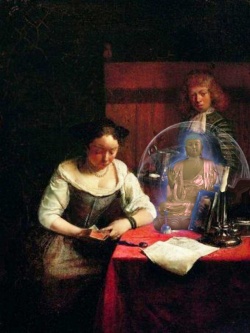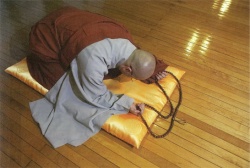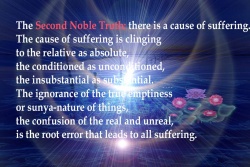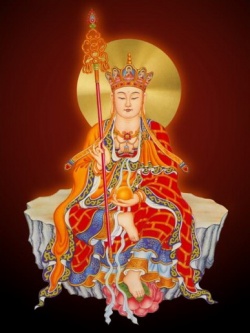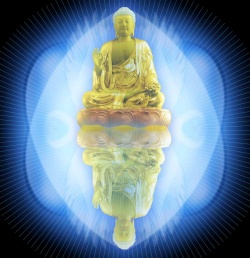Uddyotakara's Quotations from Dharmakiirti and Viniitadeva
- Uddyotakara is well known as a Braahma.na logician and author of a sub-commentary on Gotama's Nyaaya-suutra called the Nyaaya-vaartiika, in which he mentions two treatises on Logic called respectively the Vaadavidhi and Vaadavidhaana-.tiikaa.
The definition of a, proposition (pratij~naa) given in the Vaadavidhi is thus quoted by Uddyotakara: Yad api Vaadaavidhau "saadhyaabhidhaana^m pratij~naa" iti pratij~naalak.sa.nam uktam...(Nyaayavaaarttika, 1-33, pp. 121, ASB.).
Though in the Vaadavidhi, 'a proposition is the speaking out of that which is to be established,' is-given as the definition of a, proposition...." In criticizing Dignaaga's definition of a side (Pak.sa) Uddyotakara extracts a passage from the Vaadavidhaana.tika in which that definition has been supported: Yad api Vaadavidhaana-.tiikaayaa^m saadhayaatiiti 'sabdasya "svaya^m pare.na ca tulyatvaat svayam iti vi'se.sa.nam"... (Nyaayavaarttika, 1-33, p. 120, ASB.).
"In the Vaadavidhaana-.tkaa the qualifying clause 'by one's self' is no doubt justified on the ground that a side Pak.sa taken up by a person is to be established by himself and not by any other, though it might be established by the latter as well."
In the following passage Uddyotakara cites the definition of a discussion (vaada) as given in the Vaadavidhaana-.tiikaa: Apare tu "sva-para-pak.sa- siddhyasiddhyartha^m vacana^m
- vaada" iti vaadalak.sa.na^m var.nayanti (Nyaayavaarttika, 1-42, p. 151, ABS.). "Others again define a discussion vaada thus: a discussion consists of assertions for the establishment of one's own side and refutation of the other side."
- The: Tibetan Versions
- Now, the Vaadavidhi is only another name for the Vaadanyaaya by Dharmakiirti, while the Vaadavidhaana-.tiikaa is identical with the Vaadanyaaya-.tiikaa by Viniitadeva.
The original Sanskrit texts of these two works are not available, but the Tibetan versions of them, called respectively Rtsod-pahi-rigs-pa and Rtsod-pahi-rigs-pahi hgrel-wa are contained in volumes Ce and Ze of the Tangyur.
Dharmakiirti's definition of a proposition (pratij~naa) quoted by Uddyotakara from the Vaadavidhi or Vaadanyaayaa is identified in the Tibetan version of that work with what follows: Dam-bcah-pa ya^n bsgrub-bya bstan-pahi phyir-ro (Vaadanyaaya in Tangyur, Mdo; Ce, fol. 399).
" A proposition serves the purpose of showing what is to be established." Similarly the passage relative to the definition of a side (Pak.sa) extracted by Uddyotakara from Viniitadeva's Vaadavidhaana-.tiikaa or Vaadanyaaya-.tikaa, is identified in the Tibetan version of that work with the following:
Bdag- ~nid-ma-yin-pahi ^no-wo-ni bdag-~nid-kyi ^no-wo-ni gshan-gyi ^no-wo ma-yin-no shes-bya-wahi don-to (Vaadanyaaya-.tiikaa in Tangyur, Mdo, Ze, fol. 50).
"The clause 'by one's self' signifies that the side Pak.sa taken up by a person is to be established by himself and not by any other."
The definition of a discussion (vaada) quoted by Uddyotakara from the Vaadavidhaana-.tiikaa or Vaadanyaaya-.tiikaa is identified in the Tibetan version of that work with the following: Rgol-wa da^n phyir-rgol-wa dag-gis ra^n da^n gshan-gyi don grub-par-byed-pa da^n (ma) grub-pahi don-du
- brjod-nas rtsod-pa yin-no (Vaadanyaaya-.tiikaa in Tangyur, Mdo, Ze, fol. 41). " A discussion consists of assertions: by a disputant and his opponent for the establishment of their respective side and refutation of the opposing side."
- Dharmakiirti Cites Uddyotakara
- Dharmakiirti in his Nyaayabindu mentions a 'saastra (dogmatic work) which refers evidently to the Nyaayavaarttika, and a "'saastrakaara" (author of the dogmatic work) who seems to be the same as Uddyotakara.
The passage of the Nyaayabindu, which refers to the 'saastra and 'saastrakaara, runs as follows: Svayam iti vaadinaa yas tadaa saadhanam aaha. Etena yady api kvacic chaastre sthitasaadhanam aaha, tacchaastrakaare.na tasmin dharmi.ny anekadharmaabhyupagame 'pi yes tadaa tenet vaadinaa dharma.h svaya^m saadhayitum i.s.ta.h sa eva saadhyo netara ity ukta^m bhavati (Nyaayabindu, ch. iii, pp. 110-11, Peterson's edition).
"'By one's self' refers to the disputant who undertakes to establish a property.
In a certain 'saastra this clause has been considered redundant: but it serves the purpose of indicating that though the author of the 'saastra admits many properties as belonging to a, thing, the property to be established is the one which is chosen by the disputant himself and not any other."
The passages quoted above induce me to conclude that Dharmakiirti, Viniitadeva, and Uddyotakara were contemporaries, and that the Vaadavidhi and Vaadavidhaana.preceded the Nyaayavaarttika, while the Nyaayabindu followed it.
Subandhu, Baa.Na, Har.Sa, And Hiuen-Thsang
The Vaasavadattaa, an immortal work of the poet Subandhu, mentions(1) Uddyotakara as a rescuer of the _____________________________________________________
1. Nyaayasthitim iva Uddyotakarasvaruupaa^m Bauddhasa^ngatim iva ala^nkaarabhuu.sitaam... Vaasavadattaa^m dadar'sa (Vaasavadattaa, p. 235, Hall's edition).
Nyaaya, while the Vaasavadattaa itself is mentioned(1) in the Har.sacarita by Baa.na as a classical work which humbled the pride of all previous poets.
The Har.sacarita describes Baa.na as a poet who lived at the court of King 'Srii Har.sa or Har.savardhana; and the manner in which the poet introduces himself(2) in the work leaves no room for doubt that he was a very young man while his patron the king was mature in age and experience.
King Har.sa reigned in Thaane'svara during the whole of the period (A.D. 629-44) that the Chinese pilgrim Hiuen-thsang travelled through India.
This leads us to conclude that Baa.na flourished about A.D. 650. which is the latest date that can be assigned to Uddyotakara. As Dharmakiirti lived about A.D. 635(3) his contempory, Uddyotakara, must have flourished about A.D. 635-50.
The Residence Of Uddyotakara
The name Bhaaradvaaja(4) as applied to Uddyotakara is derived from the family to which he belonged, while he _____________________________________________________
1. Kaviinaam agalad darpo nuuna^m Vaasavadattayaa 'Saktyeva Paa.n.duputraa.naa^m gatayaa kar.na-gocaram (Har.sacarita, Ucchvaasa i).
2. p.r.s.thato ni.sannasya Maalavaraajasuunor akathayat "mahaan aya^m bhuja^nga" iti... Braahma.no smi jaatah somapaayinaa^m va^m'se Vaatsyaayanaanaam yathaakaalam upanayanaadaya.h k.rtaa.h sa^mskaaraa.h samyak pa.thita.h saa^ngo veda.h 'srutaani yathaa'sakti 'saastraa.ni daara-parigrahaad abhyaagaariko smi kaa me bhuja^ngataa? (Har.sacarita, Ucchvaasa ii, p. 58, II'svarachandra Vidyaasaagara's edition).
One day Ring Har.sa while sitting in his court looked back towards the Prince of Malwa and spoke of Baa.na as follows: "This [Baa.na] is a great 'bhuja^nga' [[[Wikipedia:snake|snake]] or dissolute person." Baa.na remaining mute for a while replied thus: "
I am by birth a Braahma.na descended from the Soma-drinking Vaatsyaayana family, have duly passed through all the sacraments, such as the wearing of a sacred thread, etc., have studied. completely the whole Veda with its auxiliary parts, have listened to the 'saastras to the best of my power, and have, by accepting a wife, become a householder: wherein, then, consists my bhuja^ngataa [snakishness or dissoluteness]?"
3. For the date of Dharmakiirti see my History of the Medieval School of Indian Logic, p. 105, published by the University of Calcutta.
4. Iti 'Srii-paramar.si-Bhaaradvaaja-Paa'supataacaary 'Sriimad-Uddyotakara-k.rtau Nyaayavaarttike pa~ncamo 'dhyaaya.h (Nyaayavaarttika, colophon).
is called Paa'spataacaarya on account of his being a preceptor or' the Paa'supata 'Saiva sect.
Nothing is definitely known as to the place in which Uddyotakara was born.
The only place mentioned by him is 'Srugh.na, which is situated on the western Jumna canal 40 miles north of Thaane'svara
The passage of the Nyaayavaarttika in which he mentions 'Srugh.na runs as follows: E.sa panthaa.h 'Srugh.na^m gacchati (Nyaayavaarttika, 1-33, p. 113), "
This way leads to 'Srugh.na."
From this it appears that Uddyotakara, while writing the NyByavaarttika, resided at Thaane'svara, which was connected with 'Srugh.na by a high road.
It was very probably this route(1) by which Hiuen-thsang reached 'Srugh.na on April 1, A.D. 635.
Thaane'svara was a great centre of learning about the time when Har.saavardhana reigned there.
It is not unlikely that Uddyotakara received some time in his career patronage at the court of Thaane'svara.
He seems, however, to have been a native of Padmaavatii, the modern Narwar in Malwa, which was a headquarter of the Paa'supata cult, and in which names such as Uddyotana, similar to Uddyotakara, occur.
It was perhaps owing to the skill of this able controversialist that Padmaavatii acquired so much renown as a seat of Nyaaya philosophy.
In the Maalatii-maadhava, a Sanskrit play composed by Bhavabhuuti early in the eighth century A.D., we read of Maadhava and his friend Makaranda going from Vidarbha to Padmaavatiitii to prosecute their studies in AAnviik.sikii (Nyaaya).(2) _____________________________________________________
1. Vide Beal's Buddhist Records, pp. 186-90. Cunningham observes: "The importance of the position [of 'Srugh.na is shown by the fact that it stands on the high road leading from the Gangetic Doab, via Mirat, Saharanpur, and Ambala, to the Upper Panjab and commands the passage of the Jumna.
By this route Mahmud of Ghazni returned from his expedition to Kanoj, by this route Timur returned from his plundering campaign at Haridwar, and by this route Baber advanced to the conquest of Delhi " (Ancient Geography of India, p. 347).
2. Tad idaanii^m Vidarbharaajamantri.naa sataa Devaraatena Maadhava^m putram aanviik.sikii'srava.naaya Ku.n.dinapuraad imaa^m Padmaavatii^m prahinvataa savihitam (Maalatii-maadhava, Act. I).
The defiance(1) hurled at the Buddhist logicians by Uddyotakara, in the opening lines of his Nyaayavaarttika and the host of Buddhist logical treatises criticized by him in the work, prove beyond a doubt that he was a logician of no small eminence, whose name shed lustre on the place of his birth. _____________________________________________________
1. Yad Ak.sapaada.h pravaro muniinaa^m 'samaaya 'saastra^m jagato jagaada Kutaarkikaaj~naananiv.rttihetu.h kari.syate tasya mayaa nibandha.h (Nyaaya vaarttika, opening line).
